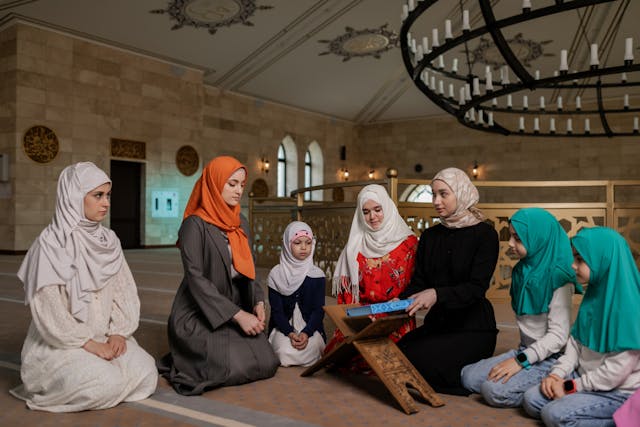How to Make Tajweed Easy and Fun for Kids
Teaching the Holy Quran is one of the most rewarding experiences for parents and teachers.
But when it comes to Tajweed, most parents wonder how to make Tajweed easy and fun for kids?
How can such subtle pronunciation rules and principles be understood by small minds?
The good news is that learning Tajweed doesn’t have to be difficult.
If the right approach is adopted, interesting activities are used, and a little creative thinking is involved, learning Tajweed for kids can be a joyful and spiritual journey.
In my 20 years of teaching experience, I have seen that children can become experts in Tajweed with patience, play, and love.

Why is Tajweed important for kids?
First of all, it is important to understand why the principles of Tajweed are important for elementary students.
Tajweed is the art of reciting the Quran as it was revealed.
If children are taught correct pronunciation at an early age, they will have no difficulty in correcting mistakes later.
When children learn to recite the Quran correctly, they gain confidence in reciting.
They begin to understand that if a letter is pronounced incorrectly, the meaning can change.
This makes them love the Quran more and feel proud of their beautiful recitation.
1. Adopt easy and interesting methods for children
The secret to success is to make the lesson light, colorful and interesting.
Easy methods for teaching Tajweed to children are those that include color, sound and visual style.
For example, make flashcards of Arabic letters, use colorful rules, or show short videos that explain pronunciation.
When I teach children the exit points i.e. the places where the sound comes out I ask them to feel their tongue, throat or lips to see where the sound is coming from.
Tajweed tips for young children can be made more interesting with stories, poetry or practicing in front of a mirror.
The goal should be for the child to learn the Quran with Tajweed but not feel pressured or bored.
2. Make the lesson interesting and interactive
Today’s children live in the digital age, so using technology is beneficial.
Online Tajweed classes for children nowadays teach through apps and games that have a voice recognition system, which immediately corrects the child’s pronunciation mistakes.
You can also use interactive means of learning the Quran such as quizzes, games or visual lessons.
An interesting game is “Recognize the letter”, in which the child listens to the sound and points to the correct letter.
These small activities make learning Tajweed a fun process for children.
Also Read: What is Qirat in Islam? Complete Guide for Beginners
3. Create a daily routine
Success in teaching Tajweed depends on consistency.
If you take out even 15 minutes every day, you can easily teach Tajweed to children.
Morning hours are best because the mind is fresh and the environment is calm.
Celebrate your child’s small successes.
When they pronounce a difficult word correctly, praise them, give them a sticker, or give them a compliment.
This process makes learning Tajweed easier for children because they are learning with joy.
Every child learns differently some learn by ear, some by writing, and some by seeing.
It is important to understand their style.
4. Link learning to games and stories
Children love stories.
Teach Tajweed through Islamic fun education for example, tell stories of famous reciters, or hold competitions in which children see which “qaf” reads the most clearly.
You can incorporate coloring activities, Arabic letter cards, or phonic exercises in the form of games.
This way, the principles of Tajweed do not seem dry, but become interesting.
5. Practice listening and repetition
The most effective way for children to learn basic Tajweed is to listen repeatedly.
Tell them to listen to the recitation of famous reciters like Mishary Rashid or Abdul Rahman Al-Sudais.
This way their ears get used to the pronunciation and intonation.
After listening, repeat the same verse to the child.
If you make it a game like clapping for each Tajweed rule it becomes easier for the child to remember it.
6. Digital and home learning resources
Online education has created convenience for parents.
Now, online Tajweed classes for children have expert teachers who teach children to read the Quran with fun.
If you want to teach at home, you can use YouTube, mobile apps or colorful Qurans that make Tajweed easy for children.
The important thing is to choose a platform that combines both correct pronunciation and interest.
7. Parents themselves should be role models
Children do what they see.
If parents themselves read the Quran with Tajweed, children try to learn automatically.
Make it a daily routine to recite the Quran whether after Fajr or before bed so that children see it as part of their lives.
Even if you are just learning, this practice will motivate them.
They will understand that learning the Quran is a lifelong journey.
8. Patience and Encouragement
Every child learns at their own pace.
Some understand quickly, some take time.
Never compare.
Celebrate their small successes.
Record their recitations so they can see their own improvement.
The real beauty of learning Tajweed is that children connect to the Quran with love, not pressure.

9. Prayer and Encouragement
Finally, the most important thing is prayer.
Pray for your children that Allah makes it easy for them to learn the Quran with Tajweed.
Tajweed is not just the knowledge of words it is an art that connects with the heart.
When children feel the love, sincerity, and attention of their parents, they naturally become more devoted and motivated to recite beautifully.
Also Read: What Is the Best Dua for a Good Day in Islam – Begin Your Day with Allah’s Blessings
FAQs
How to teach kids Tajweed?
To teach kids Tajweed, start with simple pronunciation practice, color-coded Quran pages, and interactive Tajweed games that use visuals and sounds. Keep the lessons short, joyful, and consistent. Use rhymes, stories, or mirror exercises to help them understand the Tajweed rules for beginners. Even 10–15 minutes of daily recitation with Tajweed can help kids master correct pronunciation naturally.
How to make Arabic fun for kids?
Make Arabic fun for kids by using songs, flashcards, storytelling, and interactive games. Turn Arabic letters into colorful visuals and connect them with real-life objects or short stories. You can also use Arabic learning apps that combine animation and sound. When kids see Arabic as a fun challenge, they engage more and remember faster.
How to make Quran fun for kids?
To make Quran learning fun for kids, mix games, stories of prophets, rewards, and recitation challenges. Use child-friendly Quran apps that let them track progress and earn stars. Encourage them to imitate the beautiful recitations of their favorite Qaris. Create a loving, pressure-free atmosphere where the Quran feels like a source of joy, not a task.
What are the 7 rules of Tajweed?
The 7 main rules of Tajweed include: Ikhfa, Idgham, Iqlab, Izhar, Madd, Qalqalah, and Ghunna. Each rule helps improve pronunciation and beautify Quran recitation. Teaching these Tajweed rules to kids with examples, colors, and visuals makes them easy to remember and apply in daily reading.
What are the four pillars of Tajweed?
The four pillars of Tajweed are Makharij (points of articulation), Sifaat (characteristics of letters), Rules of Noon and Meem, and Proper Waqf (stopping rules). These form the foundation of correct Quran recitation. Kids can learn these gradually through interactive Tajweed lessons and guided recitations.
Can I pray without Tajweed?
Yes, you can pray without perfect Tajweed as long as your recitation is correct and understandable. However, learning basic Tajweed for children and adults enhances the beauty, accuracy, and meaning of the Quran. Even small improvements in pronunciation bring you closer to the true recitation style of the Prophet ﷺ.



